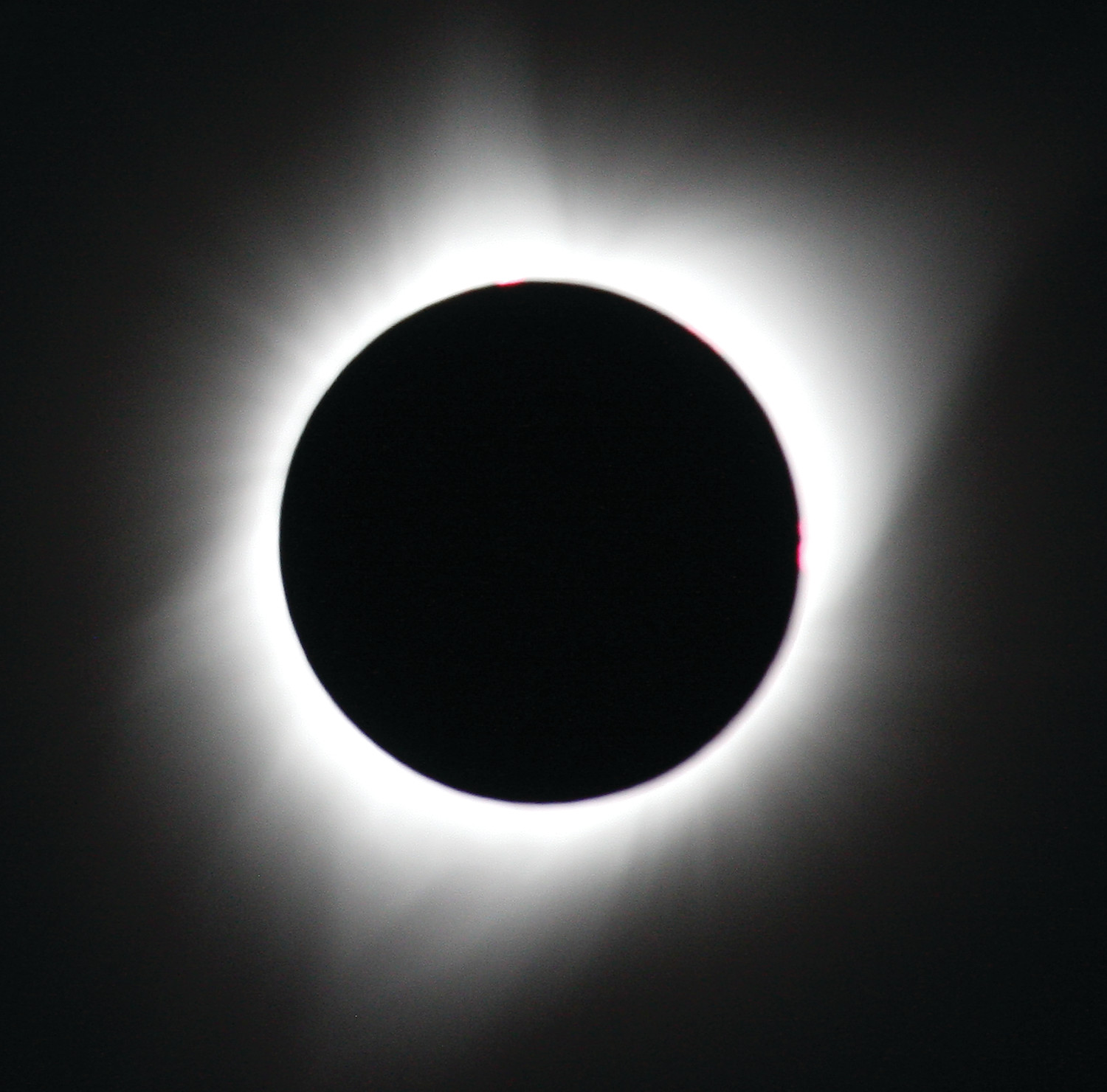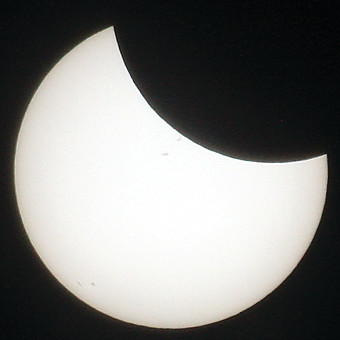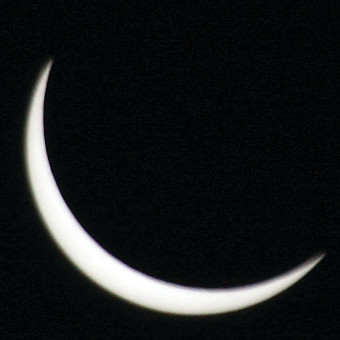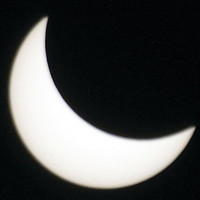Support the Timberjay by making a donation.
There goes the sun
Our quest for totality was a family affair
It was half an hour before Monday’s solar eclipse began when we made the decision to race to the blue. It’s one key piece of advice for eclipse geeks, who already know when it isn’t safe to …
This item is available in full to subscribers.
Attention subscribers
To continue reading, you will need to either log in to your subscriber account, or purchase a new subscription.
If you are a current print subscriber, you can set up a free website account and connect your subscription to it by clicking here.
If you are a digital subscriber with an active, online-only subscription then you already have an account here. Just reset your password if you've not yet logged in to your account on this new site.
Otherwise, click here to view your options for subscribing.
Please log in to continue |
There goes the sun
Our quest for totality was a family affair
It was half an hour before Monday’s solar eclipse began when we made the decision to race to the blue. It’s one key piece of advice for eclipse geeks, who already know when it isn’t safe to look at the sun and don’t need to be reminded by the talking heads on television every five minutes. The thing to really remember on eclipse day is: stay mobile.
That was our strategy when we made hotel reservations in Lincoln, Neb., almost a year ago. Lincoln was in the path of totality, but just barely, which meant we would be moving somewhere else on eclipse day, based on the weather forecast. A few clouds, after all, can turn a truly jaw dropping event into a yawner.
In this case, we turned the eclipse into a brief family reunion, with three generations from four states converging on Lincoln two days ahead of the big event.
For weeks ahead of the eclipse, my brother Zac and I explored satellite images from Google Earth, looking for viewing options within the 70-mile wide path of totality that neatly bisected Nebraska in a shallow arc. The eclipse ran coast-to-coast, but we chose Nebraska based on its relative proximity and its meteorological tendency for clear skies in August. We strategized by phone and email, weighing the options. For a time, we had settled on viewing the eclipse from Homestead National Monument, about 45 miles south of Lincoln. It was set to be NASA’s eclipse headquarters, and Bill Nye the Science Guy was going to be broadcasting live from this monument to the Homestead Act. It had the potential to be quite a scene. But the forecast had grown increasingly more pessimistic in the days leading up to the eclipse. We poured over cloud forecasts for two days ahead of time, and by Monday morning we had made the decision to head due west, to Grand Island, where forecasters expected a brief window of relatively clear skies before the possibility of late afternoon thunderstorms.
Despite our preparations, we had no idea what to expect on Eclipse Day. The television, as usual, was hyping the logistical challenges the event might bring as potentially millions of additional people headed into the path of totality. Traffic could be backed up for hundreds of miles, gas stations would run dry, toilet paper reserves would be exhausted, restaurants would be overrun and people might be forced to resort to cannibalism. Oregon declared a state of emergency and deployed the National Guard.
We figured an early start was our best line of defense, so we hit the road at about 5:30 a.m. I-80, heading west from Lincoln, was experiencing only light traffic. It was smooth sailing to Grand Island, where we set up in a nicely-treed state recreation area located just off I-80 in an island of the Platte River. We spent the morning birdwatching, walking, and obsessing over the on-and-off banks of clouds that kept filtering into the area from the south. We had parked near the park’s exit so we could make a quick get-away if necessary to find clear skies. We were on a boundary of sorts. The skies to the north and west had remained clear all morning and we scoped out a couple spots in that direction on Google maps as potential options.
With the eclipse set to begin around 11:30 a.m., we set 11 as our decision point: stay or move. And with more clouds rolling in, my sister and I offered to scout out locations under the blue. It was quickly clear to us that viewing conditions would improve dramatically as we moved several miles north and west, so we called the others to let them know to follow. And that’s how we spent the first 15 minutes of the eclipse, making a mad dash down Nebraska backroads looking for perfectly clear skies.
For my mother and my siblings, it was déjà vu, harkening back to 1979 when the family, with my father at the wheel of the our van, had made a desperate last minute dash across the Manitoba prairie looking for a patch of blue. That was the last time a total solar eclipse passed anywhere near Minnesota. It was February, and the whole northern plains had been socked in with winter stratus for days. We had made the trip anyway, spending the night before in Grand Forks. We didn’t have the Internet in those days, of course, so we were dependent on the radio to hear the weather forecasts. The morning of the eclipse, the forecast offered little hope, other than a slight chance of clearing further west. So we crossed the border and started heading that way, with my brother, who had pestered us all for months to go see the eclipse, all but hysterical in the back of the van. We were listening to CBC radio for the latest forecast and an excited announcer finally broke into the broadcast to announce: “It’s clearing by Brandon!”
We were already headed that direction, but Brandon was still a long way off. My dad floored it. I have no idea how fast we were going on that Canadian highway, but he got us there in one piece and we pulled off the road on the edge of a snow-covered field under a patch of blue that never looked more heaven-sent.
Our adventure this week was slightly less frantic, but we ended up, once again, pulling off on the side of a gravel road and setting up our telescopes, camera, and viewing chairs on the edge of a cornfield. We watched the phases of the partial eclipse with our special glasses until the moment of totality, when we trained our unfiltered telescopes, binoculars, camera, and naked eyes on a sight of wonder.
In the weeks leading up to the eclipse, people asked us why we would go through the trouble of traveling all that way when we could see the partial eclipse right from home. Invariably, that question is asked by people who have never seen a total eclipse. Anyone who has experienced totality already knows the answer. In that moment when the sun blinks out, revealing the diamond ring of the sun’s corona, when you can watch as solar flares shoot from the sun’s surface, you will have a memory etched in your brain forever. I still remember the view of a giant solar flare, viewed from our telescope back in 1979, like it was yesterday.
Unfortunately, two-and-a-half minutes is over just like that, and watching the backside of the partial eclipse following totality, is the definition of anti-climactic.
Shortly after the sun peeked out again, we packed up, said our goodbyes and headed out to our various destinations. And while the traffic hadn’t been an issue on our arrival, the trip back to Minnesota turned into a nearly 12-hour-long white knuckle odyssey through a traffic jam that stretched from Nebraska to Minnesota. We rolled into the Twin Cities at about 12:30 a.m., where we spent the night with family before heading home on Tuesday, with memories that will last the rest of our lives.
Of course, we’re already making plans for the next U.S. eclipse, set for 2024. I expect another last minute race to the blue.















